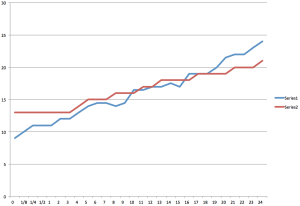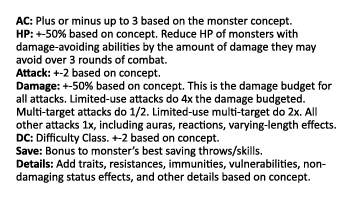Morrus said:
IME WotCs CRs are often pretty off. And CR is such a nebulous thing anyway.
So people keep saying that.
Do you have, say, 5 monsters that are not wierd (intellect devourers are wierd, for example) which you find are far off proper CR?
Because I keep seeing this claim, but it is always vague.
Guess it depends on what you mean by "far off" and "proper CR."
EDIT: We might say, well, the DMG was printed after the MM by a few months, so the DMG should be the "proper way" to calculate CR. But that may not necessarily be true. That's part of the premise of Paul Hughes' argument – that actual play experience and playtesting of MM monsters points the way to the "proper way" to calculate CR, and the DMG method is flawed. The thing to pay attention to are when there are discrepancies between what the DMG method says, what's in the monster stat block (MM, VGtM, MToF, etc), and/or the actual play experience with that monster.
One monster that comes to mind is the
quickling, which is listed as CR 1 in VGtM.
However, if we run the maths for a quickling using the DMG guidelines on page 274, we easily get a CR 3 monster. In fact, depending on how you factor Evasion (I did not factor it at all in my maths below), the quickling could even be a CR 4... something to consider if you start to assume I've overestimated the value of Blurred Movement.
I bring this one up because it's notable for being printed in November 2016, about two years
after the DMG was printed in December 2014. My thinking being if there were some numbers they needed to iron out post release, you'd assume this sort of discrepancy might be apparent between the DMG and MM, but not between the DMG and the later VGtM.
Quickling, Defensive CR = 2
HP 10 indicates we start at CR 1/8
Effective AC = 16 + 5 (Blurred Movement) = 21, which bumps it up four times to CR 2
NOTE: Evasion may be worth +1 or +2 AC, but I'm leaving it out for now since there's nothing codified in the DMG to easily compare it to, and it would be more on the "art" or "fine-tuning" side of the monster design.
Quickling, Offensive CR = 5
DPR 25.5 indicates we start at CR 3
Attack bonus +8 indicates we bump that up twice to CR 5
Quickling, Total CR = (2 + 5) / 2 = 3.5
Thankfully, I used the quickling encounter later on after I had more experience DMing 5e and I caught this error and was able to course correct in my encounter design. However, that wasn't the case when I'd just started DMing 5e...
Another monster that comes to mind is the
hobgoblin. The DMG maths confirm that it is a CR 1/2 monster as listed. Even when you factor in Martial Advantage you are still within rounding down range of CR 1/2. Technically, it should play like a CR 1/2 monster.
However, actual play experience with hobgoblins engaging in melee with 1st level PCs tells me they are far more dangerous than, say, a
thug (CR 1/2) or a
gnoll (CR 1/2). This is because on a good roll with Martial Advantage, a hobgoblin can potentially one-shot kill a fresh 1st level PC. Say the 1st level rogue has 8 HP. Hobgoblin rolls 7 damage with longsword, 9 damage on Martial Advantage, and suddenly that PC is at -16 (negative their max hit points), and they're dead in one round. We might expect that kind of play experience from, say, an
ogre (CR 2), and 1st level players would rightfully be very cautious around it, but that potential for a sharp spike in damage from a CR 1/2 hobgoblin is pretty jarring when it happens at your table. I knew how to foreshadow the ogre's threat, but with two hobgoblin sentries I didn't have a clear way to foreshadow how deadly they could be; in part, this was because I didn't have the handy CR to alert me "hey, this monster might be really dangerous for your 1st players." At least, that was my play experience.





